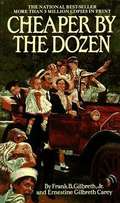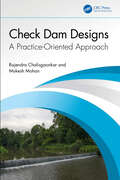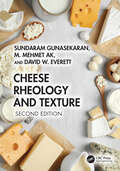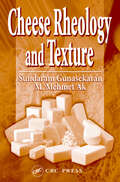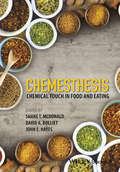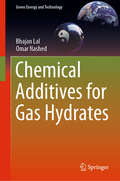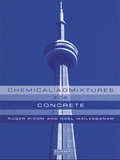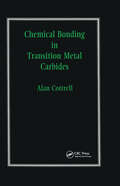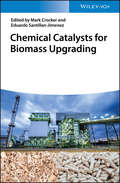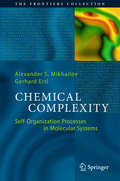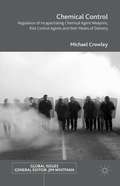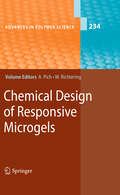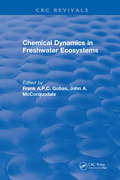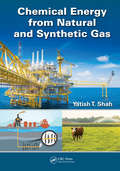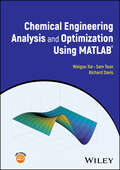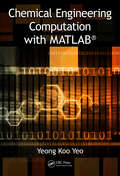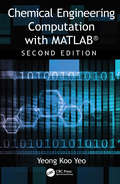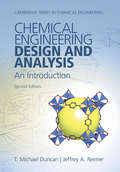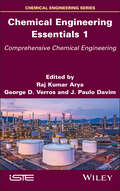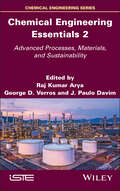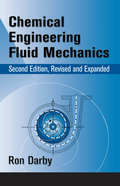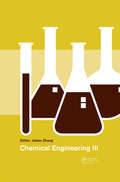- Table View
- List View
Cheaper by the Dozen
by Ernestine Gilbreth Carey Frank B. GilbrethThis is the true story of the Gilbreth family. It is often humorous, sometimes tender, always poignant. Frank and Lillian Gilbreth changed the way many jobs were done. They balanced professional careers with raising twelve children--six boys and six girls--long before it was the norm. This edition contains the entire text of the original edition, and teens and adults will find this book to be delightful and entertaining.
Check Dam Designs: A Practice-Oriented Approach
by Rajendra Chalisgaonkar Mukesh MohanCheck dams are small barriers built across the direction of water flow on shallow rivers and streams for the purpose of water harvesting. This book is a review of basic principles and practice-oriented approaches for check dam designs. It offers a hands-on approach with a strong, practical bias helpful in solving problems that are likely to be encountered in real-life field situations. It has been divided into nine chapters dealing with design details for gabion, masonry, concrete, and rubber check dams, including briefs about topographical surveys and geotechnical and hydrological investigations.Features: Gives insight into the principles of design and construction of check dams. Includes data assumptions and design principles along with design philosophy. Discusses design of gabion, masonry, and concrete check dams. Contains illustrative examples along with 20 engineering drawings and 140 quick solution tables for design of gabion, masonry, and concrete check dams. Explores easy-to-use tables for design of masonry and concrete retaining walls. This book is aimed at professionals, students, researchers, and practitioners in civil engineering, hydrology, and water conservation.
Cheese Rheology and Texture
by Sundaram Gunasekaran M. Mehmet Ak David W. EverettResearch on the rheological and textural aspects of cheeses has continued to progress, with new measurement methods, and technological and physiochemical insights having been developed since the publication of the first edition over 20 years ago. The second edition of Cheese Rheology and Texture continues to bring together essential information on the rheological and textural properties of cheese and state-of-the-art measurement techniques, including the most up-to-date findings.This comprehensive resource begins with an overview of cheesemaking technology and provides a detailed description of fundamental rheological test methods, including uniaxial testing and fracture mechanics, the theory and applications of linear viscoelastic methods (dynamic testing), and nonlinear viscoelasticity of cheeses. The book focuses on mechanics in the examination of cheese texture while emphasizing measurement methods in the discussion of cheese meltability and stretchability. Finally, it addresses the effects of various factors, such as the composition and properties of milk, cheesemaking procedures, and post-manufacturing processes, on the structure of cheese and the impact on functional properties.Key Features: Includes new and updated figures and tables Presents new studies and developments in measurement methods, instruments used, and data analysis techniques Includes rearranged and updated chapters with improved clarity and the latest research Summarizing the vast literature available on the subject and including the most current developments, Cheese Rheology and Texture, Second Edition continues to help those in the dairy industry and academia choose the proper techniques to measure properties that directly relate to food applications and ensure that cheese in their formulations will function as intended.
Cheese Rheology and Texture
by Sundaram Gunasekaran M. Mehmet AkCheese Rheology and Texture is the first reference to bring together the essential information on the rheological and textural properties of cheese and state-of-the-art measurement techniques.This comprehensive resource begins with an overview of cheesemaking technology and detailed descriptions of fundamental rheological test methods. Then
Chef's Guide to Charcuterie
by Jacques BreveryCharcuterie, the art of transforming pork meats into various preparations as an array of dishes, has traditionally held a very important place in gastronomy. An art that demands serious attention by the chef, its success depends not only on the execution but also on the presentation. Chef's Guide to Charcuterie demonstrates how to transform lesser
Chemesthesis: Chemical Touch in Food and Eating
by David A. Bolliet John E. Hayes Shane T. McdonaldChemesthesis are the chemically initiated sensations that occur via the touch system. Examples in the mouth include the burn of capsaicinoids in chilies, the cooling of menthol in peppermint, and the tingle of carbonation. It is physiologically distinct from taste and smell, but is increasingly understood to be just as important as these senses for their contribution to flavor, especially with the sustained growth in interest in spicy foods from around the world. Chemesthesis: Chemical Touch in Food and Eating surveys the modern body of work on chemesthesis, with a variety of contributors who are well known for their expertise on the topic. After a forward by John Prescott and an introduction by Barry Green (who originally coined the term chemesthesis 25 years ago), the book moves on to survey chemesthetic spices and address the psychology and physiology of chemesthesis; practical sensory and instrumental analysis; the interaction of chemesthesis with other chemical senses; health ramifications; and the application of chemesthesis in food. The major types of chemesthesis, including pungency/burning, cooling, tingling, nasal irritation, and numbing, are each covered in their own chapter. The book concludes with a look to the future. This is the first comprehensive book on chemesthesis since 1990, when Barry Green and his colleagues edited a volume on the perception of chemical irritants, including those in food. This new book is intended to be a vital resource for anyone interested in the sensory impact of the food we eat, including food scientists, sensory professionals, analytical chemists, physiologists, culinary scientists, and others.
Chemical Additives for Gas Hydrates (Green Energy and Technology)
by Bhajan Lal Omar NashedThis book offers a straightforward, informative guide to the chemicals used for gas hydrate formation and inhibition, providing the reader with the latest information on the definition, structure, formation conditions, problems, and applications of gas hydrates. The authors review not only the inhibitors used to prevent or mitigate hydrate formation, but also the conditions under which it is necessary to form hydrates quickly, which require the use of promoters. Various promoters are discussed, including their specifications, functions, advantages and disadvantages. The possibility of using natural reservoirs of gas hydrate as an energy source is also considered. Lastly, due to the difficulty of conducting experiments that reflect all conditions and concentrations, the book presents a number of models that can predict the basic parameters in the presence of the chemicals. Given its scope, the book will be of interest to professionals working in this field in an industrial context, as well as to researchers, undergraduate and graduate students of chemical engineering.
Chemical Admixtures for Concrete
by Noel P. Mailvaganam M.R. Rixom Daniel P. Manson Carol GonzalesChemical admixtures are used in concrete mixtures to produce particular engineering properties such as rapid hardening, water-proofing or resistance to cold. Chemical Admixtures for Concrete surveys recent developments in admixture technology, explaining the mechanisms by which admixtures produce their effects, the various types of admixtures avail
Chemical Bonding in Transition Metal Carbides
by Sir Alan CottrellThis book presents a mainly qualitative understanding of this family of materials which ranges from simple NaCl type compounds to complex chromium carbides.
Chemical Catalysts for Biomass Upgrading
by Mark CrockerA comprehensive reference to the use of innovative catalysts and processes to turn biomass into value-added chemicals Chemical Catalysts for Biomass Upgrading offers detailed descriptions of catalysts and catalytic processes employed in the synthesis of chemicals and fuels from the most abundant and important biomass types. The contributors?noted experts on the topic?focus on the application of catalysts to the pyrolysis of whole biomass and to the upgrading of bio-oils. The authors discuss catalytic approaches to the processing of biomass-derived oxygenates, as exemplified by sugars, via reactions such as reforming, hydrogenation, oxidation, and condensation reactions. Additionally, the book provides an overview of catalysts for lignin valorization via oxidative and reductive methods and considers the conversion of fats and oils to fuels and terminal olefins by means of esterification/transesterification, hydrodeoxygenation, and decarboxylation/decarbonylation processes. The authors also provide an overview of conversion processes based on terpenes and chitin, two emerging feedstocks with a rich chemistry, and summarize some of the emerging trends in the field. This important book: -Provides a comprehensive review of innovative catalysts, catalytic processes, and catalyst design -Offers a guide to one of the most promising ways to find useful alternatives for fossil fuel resources -Includes information on the most abundant and important types of biomass feedstocks -Examines fields such as catalytic cracking, pyrolysis, depolymerization, and many more Written for catalytic chemists, process engineers, environmental chemists, bioengineers, organic chemists, and polymer chemists, Chemical Catalysts for Biomass Upgrading presents deep insights on the most important aspects of biomass upgrading and their various types.
Chemical Complexity: Self-Organization Processes in Molecular Systems (The Frontiers Collection)
by Alexander S. Mikhailov Gerhard ErtlThis review volume, co-edited by Nobel laureate G Ertl, provides a broad overview on current studies in the understanding of design and control of complex chemical systems of various origins, on scales ranging from single molecules and nano-phenomena to macroscopic chemical reactors. Self-organizational behavior and the emergence of coherent collective dynamics in reaction–diffusion systems, reactive soft matter and chemical networks are covered. Special attention is paid to the applications in molecular cell biology and to the problems of biological evolution, synthetic biology and design of artificial living cells. Starting with a detailed introduction on the history of research on complex chemical systems, its current state of the art and perspectives, the book comprises 19 chapters that survey the current progress in particular research fields. The reviews, prepared by leading international experts, yield together a fascinating picture of a rapidly developing research discipline that brings chemical engineering to new frontiers. Contents: "Introduction: "Analysis, Design and Control of Complex Chemical Systems "(Alexander S Mikhailov and Gerhard Ertl)""Single Molecules, Nanoscale Phenomena and Active Particles: "Imaging and Manipulation of Single Molecules by Scanning Tunneling Microscopy "(Leonhard Grill)"Self-Organization at the Nanoscale in Far-From-Equilibrium Surface Reactions and Copolymerizations "(Pierre Gaspard)"Single Molecule and Collective Dynamics of Motor Protein Coupled with Mechano-Sensitive Chemical Reaction "(Mitsuhiro Iwaki, Lorenzo Marcucci, Yuichi Togashi and Toshio Yanagida)"Nanomotors Propelled by Chemical Reactions "(Raymond Kapral)"Biology of Nanobots "(Wentao Duan, Ryan Pavlick and Ayusman Sen)""Reaction–Diffusion Systems and Nonequilibrium Soft Matter: "Wave Phenomena in Reaction–Diffusion Systems "(Oliver Steinbock and Harald Engel)"Self-Oscillating Polymer Gels as Smart Materials "(Ryo Yoshida)"Stochastic Fluctuations and Spontaneous Symmetry Breaking in the Chemotaxis Signaling System of "Dicyostelium" Cells "(Tatsuo Shibata)"Mechanochemical Pattern Formation in the Polarization of the One-Cell "C Elegans" Embryo "(Justin S Bois and Stephan W Grill)""Oscillations and Synchronization: "Synchronization of Electrochemical Oscillators "(Mahesh Wickramasinghe and István Z Kiss)"Turbulence and Synchrony in Spatially Extended Electrochemical Oscillators "(Vladimir Garcia-Morales and Katharina Krischer)"Quorum Sensing and Synchronization in Populations of Coupled Chemical Oscillators "(Annette F Taylor, Mark R Tinsley and Kenneth Showalter)"Collective Decision-Making and Oscillatory Behaviors in Cell Populations "(Koichi Fujimoto and Satoshi Sawai)"Synchronization via Hydrodynamic Interactions "(Franziska Kendelbacher and Holger Stark)""Evolution, Synthetic Biology, and Protocells: "Emergence and Selection of Biomodules: Steps in the Assembly of a Protocell "(Susanna C Manrubia and Carlos Briones)"From Catalytic Reaction Networks to Protocells "(Kunihiko Kaneko)"Constructive Approach Towards Protocells "(Tadashi Sugawara, Kensuke Kurihara and Kentaro Suzuki)"Network Reverse Engineering Approach in Synthetic Biology "(Haoqian Zhang, Ao Liu, Yuheng Lu, Ying Sheng, Qianzhu Wu, Zhenzhen Yin, Yiwei Chen, Zairan Liu, Heng Pan and Qi Ouyang)"Readership: Graduate students and scientists interested in complex chemical systems.
Chemical Control: Regulation of Incapacitating Chemical Agent Weapons, Riot Control Agents and Their Means of Delivery (Global Issues)
by Michael CrowleyThis thoroughly researched study highlights the international community's failure to regulate contemporary state research, development, marketing and/or deployment of riot control agents and incapacitating chemical agent weapons.
Chemical Design of Responsive Microgels (Advances in Polymer Science #234)
by Walter Richtering Andrij PichMicrogels by Precipitation Polymerization: Synthesis, Characterization, and Functionalization, by A. Pich and W. Richtering * Hydrogels in Miniemulsions, by K. Landfester and A. Musyanovych * Nano- and Microgels Through Addition Reactions of Functional Oligomers and Polymers, by K. Albrecht, M. Moeller, and J. Groll * Synthesis of Microgels by Radiation Methods, by F. Krahl and K.-F. Arndt * Microgels as Nanoreactors: Applications in Catalysis, by N. Welsch, M.s Ballauff, and Y. Lu
Chemical Dynamics in Freshwater Ecosystems
by Frank A.P.C. GobasChemical Dynamics in Freshwater Ecosystems reviews the processes that control the distribution and impacts of chemical substances discharged into freshwater aquatic environments. The book focuses on the relationships between chemical emissions and the resulting ambient concentration in water, sediments, fish, benthos, plants, and other components of real aquatic ecosystems. Hydrodynamics, sediment dynamics, chemical fate processes, bioaccumulation, and food-chain transfer are major topics discussed in the book. Case studies and models are used to illustrate how quantitative predictions of chemical dynamics and behavior in the aquatic environment can be made. Chemical Dynamics in Freshwater Ecosystems is an excellent reference for aquatic toxicologists, wildlife toxicologists, wildlife biologists, environmental chemists, governmental regulators, environmental modelers, consultants, and students studying the effects of chemicals on aquatic environments.
Chemical Energy from Natural and Synthetic Gas (Sustainable Energy Strategies)
by Yatish T. ShahCommercial development of energy from renewables and nuclear is critical to long-term industry and environmental goals. However, it will take time for them to economically compete with existing fossil fuel energy resources and their infrastructures. Gas fuels play an important role during and beyond this transition away from fossil fuel dominance to a balanced approach to fossil, nuclear, and renewable energies. Chemical Energy from Natural and Synthetic Gas illustrates this point by examining the many roles of natural and synthetic gas in the energy and fuel industry, addressing it as both a "transition" and "end game" fuel. The book describes various types of gaseous fuels and how are they are recovered, purified, and converted to liquid fuels and electricity generation and used for other static and mobile applications. It emphasizes methane, syngas, and hydrogen as fuels, although other volatile hydrocarbons are considered. It also covers storage and transportation infrastructure for natural gas and hydrogen and methods and processes for cleaning and reforming synthetic gas. The book also deals applications, such as the use of natural gas in power production in power plants, engines, turbines, and vehicle needs. Presents a unified and collective look at gas in the energy and fuel industry, addressing it as both a "transition" and "end game" fuel. Emphasizes methane, syngas, and hydrogen as fuels. Covers gas storage and transport infrastructure. Discusses thermal gasification, gas reforming, processing, purification and upgrading. Describes biogas and bio-hydrogen production. Deals with the use of natural gas in power production in power plants, engines, turbines, and vehicle needs.
Chemical Engineering
by Morton M. Denn'Chemical engineering is the field of applied science that employs physical, chemical, and biological rate processes for the betterment of humanity'. This opening sentence of Chapter 1 has been the underlying paradigm of chemical engineering. Chemical Engineering: A New Introduction is designed to enable the student to explore the activities in which a modern chemical engineer is involved by focusing on mass and energy balances in liquid-phase processes. Problems explored include the design of a feedback level controller, membrane separation, hemodialysis, optimal design of a process with chemical reaction and separation, washout in a bioreactor, kinetic and mass transfer limits in a two-phase reactor, and the use of the membrane reactor to overcome equilibrium limits on conversion. Mathematics is employed as a language at the most elementary level. Professor Morton M. Denn incorporates design meaningfully; the design and analysis problems are realistic in format and scope. Students using this text will appreciate why they need the courses that follow in the core curriculum.
Chemical Engineering Analysis and Optimization Using MATLAB
by Richard Davis Weiguo Xie Sam ToanTackle challenging optimization problems with MATLAB® software Optimization techniques measure the minimum or maximum value of a given function depending on circumstances, constraints, and key factors. Engineering processes pertaining to design or manufacture involve optimization techniques at every stage, designed to minimize resource expenditure and maximize outcomes. Optimization problems can be challenging and computationally intensive, but the increasingly widely-used MATLAB platform offers numerous tools enabling engineers to tackle these essential elements of process and industrial design. Chemical Engineering Analysis and Optimization Using MATLAB® introduces cutting-edge, highly in-demand skills in computer-aided design and optimization. With a focus on chemical engineering analysis, the book uses the MATLAB platform to develop reader skills in programming, modeling, and more. It provides an overview of some of the most essential tools in modern engineering design. Chemical Engineering Analysis and Optimization Using MATLAB® readers will also find: Case studies for developing specific skills in MATLAB and beyondExamples of code both within the text and on a companion websiteEnd-of-chapter problems with an accompanying solutions manual for instructors This textbook is ideal for advanced undergraduate and graduate students in chemical engineering and related disciplines, as well as professionals with backgrounds in engineering design.
Chemical Engineering Computation with MATLAB
by Yeong Koo Yeo<p>Most problems encountered in chemical engineering are sophisticated and interdisciplinary. Thus, it is important for today’s engineering students, researchers, and professionals to be proficient in the use of software tools for problem solving. MATLAB® is one such tool that is distinguished by the ability to perform calculations in vector-matrix form, a large library of built-in functions, strong structural language, and a rich set of graphical visualization tools. Furthermore, MATLAB integrates computations, visualization and programming in an intuitive, user-friendly environment. <p>Chemical Engineering Computation with MATLAB® presents basic to advanced levels of problem-solving techniques using MATLAB as the computation environment. The book provides examples and problems extracted from core chemical engineering subject areas and presents a basic instruction in the use of MATLAB for problem solving. It provides many examples and exercises and extensive problem-solving instruction and solutions for various problems. Solutions are developed using fundamental principles to construct mathematical models and an equation-oriented approach is used to generate numerical results. <p>A wealth of examples demonstrate the implementation of various problem-solving approaches and methodologies for problem formulation, problem solving, analysis, and presentation, as well as visualization and documentation of results. This book also provides aid with advanced problems that are often encountered in graduate research and industrial operations, such as nonlinear regression, parameter estimation in differential systems, two-point boundary value problems and partial differential equations and optimization.</p>
Chemical Engineering Computation with MATLAB®
by Yeong Koo YeoChemical Engineering Computation with MATLAB®, Second Edition continues to present basic to advanced levels of problem-solving techniques using MATLAB as the computation environment. The Second Edition provides even more examples and problems extracted from core chemical engineering subject areas and all code is updated to MATLAB version 2020. It also includes a new chapter on computational intelligence and: Offers exercises and extensive problem-solving instruction and solutions for various problems Features solutions developed using fundamental principles to construct mathematical models and an equation-oriented approach to generate numerical results Delivers a wealth of examples to demonstrate the implementation of various problem-solving approaches and methodologies for problem formulation, problem solving, analysis, and presentation, as well as visualization and documentation of results Includes an appendix offering an introduction to MATLAB for readers unfamiliar with the program, which will allow them to write their own MATLAB programs and follow the examples in the book Provides aid with advanced problems that are often encountered in graduate research and industrial operations, such as nonlinear regression, parameter estimation in differential systems, two-point boundary value problems and partial differential equations and optimization This essential textbook readies engineering students, researchers, and professionals to be proficient in the use of MATLAB to solve sophisticated real-world problems within the interdisciplinary field of chemical engineering. The text features a solutions manual, lecture slides, and MATLAB program files._
Chemical Engineering Design and Analysis
by T. Michael Duncan Jeffrey A. ReimerStudents taking their first chemical engineering course plunge into the "nuts and bolts" of mass and energy balances, often missing the broad view of what chemical engineers do. This innovative text offers a well-paced introduction to chemical engineering. The text helps students practice engineering. They are introduced to the fundamental steps in design and three methods of analysis: mathematical modeling, graphical methods, and dimensional analysis. In addition, students apply engineering skills, such as how to simplify calculations through assumptions and approximations; how to verify calculations, significant figures, spreadsheets, graphing (standard, semi-log and log-log); and how to use data maps. It also describes the chemical engineering profession. Students learn engineering skills by designing and analyzing chemical processes and process units in order to assess product quality, economics, safety, and environmental impact. This text will help students develop engineering skills early in their studies and encourage an informed decision of whether to study chemical engineering. Solutions manual available.
Chemical Engineering Design and Analysis: An Introduction (Cambridge Series in Chemical Engineering)
by T. Michael Duncan Jeffrey A. ReimerThis textbook puts design at the center of introducing students to the course in mass and energy balances in chemical engineering. Employers and accreditations increasingly stress the importance of design in the engineering curriculum, and design-driven analysis will motivate students to dig deeply into the key concepts of the field. The second edition has been completely revised and updated. It introduces the central steps in design and three methods of analysis: mathematical modeling, graphical methods, and dimensional analysis. Students learn how to apply engineering skills, such as how to simplify calculations through assumptions and approximations; how to verify calculations, significant figures, spreadsheets, graphing (standard, semi-log and log-log); and how to use data maps, in the contexts of contemporary chemical processes such as the hydrogen economy, petrochemical and biochemical processes, polymers, semiconductors, and pharmaceuticals.
Chemical Engineering Essentials, Volume 1: Comprehensive Chemical Engineering (ISTE Invoiced)
by J. Paulo Davim George D. Verros Raj Kumar AryaIn an era of rapid innovation and with a focus on sustainability, Chemical Engineering Essentials provides a definitive guide to mastering the discipline. Divided into two volumes, this series offers a seamless blend of foundational knowledge and advanced applications to address the evolving needs of academia and industry. This volume lays a strong foundation with topics such as material and energy balances, thermodynamics, phase equilibrium, fluid mechanics, transport phenomena, and essential separation processes such as distillation and membrane technologies. Volume 2 builds on these principles, delving into reaction engineering, reactor modeling with MATLAB and ASPEN PLUS, material properties, process intensification and nanotechnology. It also addresses critical global challenges, emphasizing green chemistry, waste minimization, resource recovery, and workplace safety. Together, these volumes provide a holistic understanding of chemical engineering, equipping readers with the tools to innovate and lead in a dynamic and sustainable future.
Chemical Engineering Essentials, Volume 2: Advanced Processes, Materials, and Sustainability (ISTE Invoiced)
by J. Paulo Davim George D. Verros Raj Kumar AryaIn an era of rapid innovation and with a focus on sustainability, Chemical Engineering Essentials provides a definitive guide to mastering the discipline. Divided into two volumes, this series offers a seamless blend of foundational knowledge and advanced applications to address the evolving needs of academia and industry. Volume 1 lays a strong foundation with topics such as material and energy balances, thermodynamics, phase equilibrium, fluid mechanics, transport phenomena, and essential separation processes such as distillation and membrane technologies. This volume builds on these principles, delving into reaction engineering, reactor modeling with MATLAB and ASPEN PLUS, material properties, process intensification and nanotechnology. It also addresses critical global challenges, emphasizing green chemistry, waste minimization, resource recovery, and workplace safety. Together, these volumes provide a holistic understanding of chemical engineering, equipping readers with the tools to innovate and lead in a dynamic and sustainable future.
Chemical Engineering Fluid Mechanics (Second Edition)
by Raj P. Chhabra Ron Darby Ronald DarbyCombining comprehensive theoretical and empirical perspectives into a clearly organized text, Chemical Engineering Fluid Mechanics, Second Edition discusses the principal behavioral concepts of fluids and the basic methods of analysis for resolving a variety of engineering situations. Drawing on the author's 35 years of experience, the book covers real-world engineering problems and concerns of performance, equipment operation, sizing, and selection from the viewpoint of a process engineer. It supplies over 1500 end-of-chapter problems, examples, equations, literature references, illustrations, and tables to reinforce essential concepts.
Chemical Engineering III
by Jiatao ZhangChemical Engineering III includes the proceedings of the 3rd SREE Conference on Chemical Engineering (CCE 2013, Hong Kong, 28-29 December 2013) and the 2nd SREE Workshop on Energy, Environment and Engineering (WEEE 2013, which was a part of CCE 2013). The contributions discuss current practical challenges and solutions in Chemical Engineering, and
